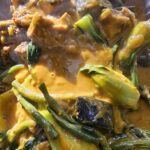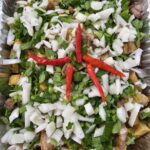Kapampangan cuisine, also known as Pampango cuisine, is a reflection of the rich history and diverse culture of the Kapampangan people in the Philippines. With its unique blend of flavors and techniques, Kapampangan food has gained recognition not only in the country but also internationally.
One of the most iconic dishes in Kapampangan cuisine is sisig. Sisig is a sizzling dish made from pig’s head and liver, seasoned with calamansi, onions, and chili peppers. It is often served on a hot plate and topped with a raw egg. The combination of savory, tangy, and spicy flavors makes sisig a crowd favorite.
Another popular dish is bringhe, a Kapampangan version of paella. It is made with glutinous rice, chicken, chorizo, and various vegetables. The use of turmeric gives bringhe its vibrant yellow color and distinct flavor. It is often served during special occasions and celebrations.
Kapampangan cuisine also offers a wide variety of soups and stews. One of the most well-known is kare-kare, a rich and creamy stew made with oxtail, tripe, and vegetables, cooked in a peanut-based sauce. It is traditionally served with bagoong, a fermented shrimp paste, and eaten with steamed rice.
Another popular soup is bulanglang, a vegetable soup made with a combination of different vegetables such as squash, okra, and string beans. It is flavored with shrimp paste and often served as a side dish.
No Kapampangan meal is complete without dessert. Tibok-tibok is a popular sweet treat made from carabao’s milk and rice flour. It has a creamy texture and is often topped with latik, a syrup made from coconut milk and sugar. Another must-try dessert is halo-halo, a refreshing mix of crushed ice, sweetened fruits, jellies, beans, and leche flan. It is perfect for cooling down on a hot day.
Visiting Pampanga, the culinary capital of the Philippines, is a must for food enthusiasts. The province is home to numerous restaurants and street food stalls that offer authentic Kapampangan dishes. One can also learn how to cook Kapampangan food through cooking classes and workshops offered in the area.



